|
TRANSLATIONS
Next page with underpages:
|
We have encountered
pare in *Qa2-40 earlier (at nuku), where not 160
but 260 days was the measure:
...
The double Rei in *Qa2-41 is likewise to
be contrasted with the other such in *Qb5-7:
|
582 / 2 = 291 is 'one
more' than 10 * 29, and if we add 64 to 290 we will reach 12 * 29.5
= 354. It ought to mean that indeed we should divide the number of
glyphs by 2 in order to find the day numbers:
|
|
We will now change
to the H tablet:
 |
 |
 |
|
Ha3-11 |
Pa3-3 |
*Qa2-40 |
 |
 |
 |
|
Ha10-31 |
Pa10-1 |
Qa9-43 |
There are 'eye
holes' in the first line of pare glyphs, but these
holes are 'plugged' in the second line. Raven (cfr at pu)
plugged holes:
|
The
one we are speaking of ran to the edge of town. |
|
As
he was walking there, |
|
cranberries bubbled up out of the swampland. |
|
He
plugged the vent with moss. |
|
When another vent formed, he plugged it too. |
Possibly such
'plugged holes' mean the 'eyes' are there, but 'down in the
earth', as if covered by soil (or moss). A parallel with puo seems
possible:
 |
 |
|
pu |
puo |
|
|
Pare in
Ha10-31 has been mentioned at honui. With 3 glyphs per day
glyph number 240 will be at the end of day 80, or if we add 64 - at the end
of day 144 (= 8 * 18):
 |
 |
 |
 |
 |
 |
|
Ha5-19 |
Ha5-20 (236) |
Ha5-21 |
Ha5-22 |
Ha5-23 |
Ha5-24 (240) |
Instead
of counting with 3 glyphs per day, though, I would
rather prefer to count each glyph as a day, which gives 240 +
64 = 304, i.e. 4 days beyond day 300 counted from
winter solstice.
Alternatively we could count with 2 glyphs per day
and reach 240 / 2 = 120 = 5 * 24 (as in Ha5-24). Then
after adding 64
we will reach to day 184, which is in agreement with
midsummer (364 / 2) at honui in Ha5-22.
The
difference between the results of the two methods
appears to be 4 months. Depending on the points of
measurement, however, we can choose these 4 months to be for
instance 30 days long or 29Ż days long:
(304 -
184) / 4 = 30 = (300 - 180)
/ 4
(302 -
184) / 4 = 29Ż = (300 - 182)
/ 4
(472 -
360) / 4 = 28
It is possible to create an inserted 4
months period between midsummer and Te Pei by
different methods. In H a difference between 16 and
12 months has apparently been encoded by the numbers,
while in G the message has been made more explicit:
 |
54 |
 |
 |
54 |
 |
|
Ga5-10 (121) |
Ga7-6 |
Ga7-7 (177) |
Gb1-2 (232) |
|
112 = 4 * 28 |
 |
98 |
 |
76 |
 |
183 = 6 *
30.5 |
 |
|
Gb1-3
|
Gb3-15
|
Gb6-26 (409)
|
Ga5-10 (121) |
|
177 = 6 *
29.5 |
If we
begin to count the new year from Rogo in
Gb6-26, then there are 184 days up to his next
appearance at summer solstice. And hanau in Gb1-2
must be included in the lunar measure 177 days
- it is also
natural to have 'birth' at the beginning rather than
at the end. But then there will be only 111 days
for those 'extra' 4 months (which we can imagine
refer to Nga Kope Ririva, the 3 islets which
did not belong to Hau Maka but to Te
Taanga.
These
'youths' (kope) are 'standing in the water' (tutuu
vai), an expression which not only refers to the
visible truth outside the southwest corner of the
island, but which also could correspond to the
'extra' 111 glyphs, because they arrive after the
first 184 days (which maybe are representing the homeland of
Hotu Matua).
111 + 177 + 184
= 472. The kuhane of Hau Maka does not arrive
until Rogo has left (Ga5-10). If we insert a
'leap day' (not to be counted), then 177 + 183 =
360.
In Q the
'great hole' is in pare (*Qa2-40), in G it
comes with Gb1-3 (the 2nd
day of those 177 and beyond the 4 inserted special
months). 99 days later another
'great hole' arrives. These 2 'great hole' glyphs presumably
illustrate Rogo without 'vision' (a glyph
joke, because the great hole is a mata, i.e.
'eye'). The hole is in the center of his body, which
presumably means in the middle of his cycle (at 'the belly of
the Sun' like a great navel).
In H the hole
is
in honui (Ha5-22), and 5
('fire') together with 22 spells 'end of Spring
Sun'. The cyclope Polyphemus (son of Poseidon) used
a huge doorstone to 'plugg' the mouth of his cave,
and so
huge was it that it weighed more than 22 wagons could carry:
... He bore a
grievous weight of dry wood, which he cast down with a din
inside the cave, so that in fear all fled to hide. Lifting a
huge doorstone, such as two and twenty good four-wheeled
wains could not have raised from the ground, he set this
against the mouth of the cave, sat down, milked his ewes and
goats, and beneath each placed her young, after which he
kindled a fire and spied his
guests ...
Myth has
much to tell about a stone
covering an opening. The entity balancing precariously on
top of
hau
tea
in Ha5-24 (where presumably the 24 halfmonths of
spring are over) could be the 'doorstone', it is
huge enough to cover the 'navel hole' of
honui.
In
Ha5-20
tagata
has lost his head (and with it of course his eyes).
Glyph number 236 probably refers to
Te
Pei,
the dark place after 8 * 29.5 days. Maybe day 236
alludes to the blind giant Orion (Polyphemus). If
so, then
Te
Pou
and
Hua
Reva
should follow, which we possibly can read also in the
round zodiac of Dendera:
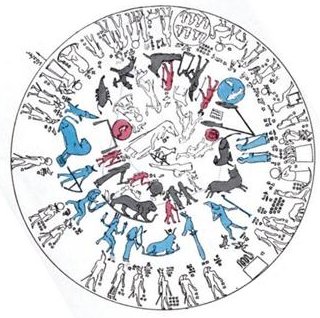
Te
Pou could be the pole upon which a bird is
perching (solstice) and Hua Reva could be the uplifted Sothis
cow hanging (reva) in the sky. Perhaps the
constellation Puppis, therefore, is Hua Reva.
Puppis is
low in the 'water' but at this time of the year higher
than otherwise.
We need
more pages in order to
compare G, H, Q, and the Dendera zodiac.
|
|
The first obvious
example, which also should be useful for us, is the stone which
covered the hidden Hotua Matua skull:
... When
Tuu Ko Ihu came out and sat on the stone underneath which he
had buried the skull, Ure Honu shot into the house like a
lizard. He lifted up the one side of the house. Then Ure Honu
let it fall down again; he had found nothing. Ure Honu
called, 'Dig up the ground and continue to search!' The search went
on. They dug up the ground, and came to where the king was. The king
(was still) sitting on the stone. They lifted the king off to the
side and let him fall. They lifted up the stone, and the skull
looked (at them) from below. They took it, and a great clamour began
because the skull had been found ...
Ure is the
proper owner of the skull and lifting the side of the hare paega
he 'rises the sky dome' as is done in spring. But the skull was not
there, it had moved on to the bottom of a hole. Digging up the
ground was necessary. The skull must be in the 'underworld', because
it follows spring. Reality moves in cycles and beyond the top there
must come a rock bottom phase, the reverse of how beyond Te Pei
comes Te Pou.
Tuu Ko Ihu was
forcefully removed from the stone he sat upon and he fell like
Taurus depicted in the Dendera round zodiac:

But the skull had
been hidden in a hole earlier too:
"... Night came, midnight
came, and Tuu Maheke said to his brother, the last-born: 'You
go and sleep. It is up to me to watch over the father.' (He said)
the same to the second, the third, and the last. When all had left,
when all the brothers were asleep, Tuu Maheke came and cut
off the head of Hotu A
Matua. Then he covered everything with soil. He hid (the
head), took it, and went up. When he was inland, he put (the head)
down at Te Avaava Maea. Another day dawned, and the men saw a
dense swarm of flies pour forth and spread out like a whirlwind (ure
tiatia moana) until it disappeared into the sky.
Tuu Maheke
understood. He went up and took the head, which was already stinking
in the hole in which it had been hidden. He took it and washed it
with fresh water. When it was clean, he took it and hid it anew.
Another day came, and again Tuu Maheke came and saw that it
was completely dried out (pakapaka). He took it, went away,
and washed it with fresh water until (the head) was completely
clean. Then he took it and painted it yellow (he pua hai pua
renga) and wound a strip of barkcloth (nua) around it. He
took it and hid it in the hole of a stone that was exactly the size
of the head. He put it there, closed up the stone (from the
outside), and left it there. There it stayed ...
The recycling of the
head seems to take a year, and the sun must stand exactly in the
right position:
Another year passed, and
a man by the name of Ure Honu went to work in his banana
plantation. He went and came to the last part, to the 'head' (i.e.,
the upper part of the banana plantation), to the end of the banana
plantation. The sun was standing just right for Ure Honu to
clean out the weeds from the banana plantation.
On the first day he hoed
the weeds. That went on all day, and then evening came. Suddenly a
rat came from the middle of the banana plantation. Ure Honu
saw it and ran after it. But it disappeared and he could not catch
it. On the second day of hoeing, the same thing happened with the
rat. It ran away, and he could not catch it. On the third day, he
reached the 'head' of the bananas and finished the work in the
plantation. Again the rat ran away, and Ure Honu followed it.
It ran and slipped into the hole of a stone. He poked after it,
lifted up the stone, and saw that the skull was (in the hole) of the
stone. (The rat was) a spirit of the skull (he kuhane o te puoko).
The
spirit of Hotu Matua (in form of the rat) had to lead the
way, not much different from how in ancient Egypt there was an
'Opener of the Way', Upwaut, for the king to be installed:
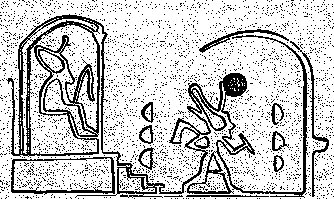
Upwaut was not a rat but another quadruped, a wolf. There are no
wolves on Easter Island. The right time for cleaning up banana
plantations was Ko Ruti according to Barthel 2:
|
Ko Ruti |
|
Cleaning of the banana
plantations, but only in the morning since the sun
becomes too hot later in the day. Problems with drought.
Good month for fishing and the construction of houses
(because of
the long days). |
It
must be summer because the days are described as long and the sun
becomes too hot for work in the middle of the day. But Ure
worked all day long, 3 days in a row. Number 3 informs us that it is
not a question of ordinary days, what is meant are the 3 periods of
spring.
This
is confirmed by Ure hanging the skull high:
...
Ure Honu
was amazed and said, 'How beautiful you are! In the head of the new
bananas is a skull, painted with yellow root and with a strip of
barkcloth around it.'
Ure Honu
stayed for a while, (then) he went away and covered
the roof of his house in Vai Matā. It was a new house. He
took the very large skull, which he had found at the head of the
banana plantation, and hung it up in the new house. He tied it up in
the framework of the roof (hahanga) and left it hanging there
...
Ko Ruti was
the 11th month of the year, which means a new year must begin in
summer:
| Marama
1. Month, light. The ancient names of the
month were: Tua haro, Tehetu'up˙, Tarahao, Vaitu nui,
Vaitu poru, He Maro, He Anakena, Hora iti, Hora nui,
Tagaroa uri, Ko Ruti, Ko Korˇ. 2. Name of an ancient
tribe. Maramara, ember. Vanaga.
Light, day, brightness, to glimmer;
month; intelligent, sensible; no tera marama,
monthly; marama roa, a long term; horau marama
no iti, daybreak; hakamarama, school, to
glimmer; hare hakamarama, school, classroom. P
Mgv.: mÓrÓma, the light, daylight; marÓma,
wise, learned, instructed, moon. Mq.: maßma,
light, broad day, bright, instructed, learned; meama,
moon, month. Ta.: marama, moon, month. In form
conditionalis this word seems derivative from lama,
in which the illuminating sense appears in its
signification of a torch. The sense of light, and of
specifically the moon, appears in all Polynesia; in
Futuna and Uvea the word signifies the world. The
tropical extension to the light of intelligence is not
found in Nuclear Polynesia, therefore not in the
Proto-Samoan, but is a later Tongafiti development.
Maramarama, bright; manava
maramarama, intelligent. P Pau.: maramarama,
intelligent. Ta.: maramarama, light, brightness.
Churchill.
The month sense is found in Tahiti,
Marquesas, Rarotonga and Maori associated with the moon
signification, and in Hawaii is specifically dissociated
therefrom to characterize a solar month. Churchill 2. |
According to Barthel 2 Ko Ruti was November (which is the
11th month of our own calendar too). But south of the equator it was
spring. If a calendar for the year is based on the sun's
movement against the background of the stars, then it is
necessary to change winter to summer, spring to autumn, etc,
when crossing the equator.
In ancient Egypt the king was reinstalled (or possibly a new
king installed) at the Sed festival:
|
"... Instead of that old, dark, terrible drama of the
king's death, which had formerly been played to the
hilt, the audience now watched a solemn symbolic mime,
the Sed festival, in which the king renewed his
pharaonic warrant without submitting to the personal
inconvenience of a literal death. The rite was
celebrated, some authorities believe, according to a
cycle of thirty years, regardless of the dating of the
reigns; others have it, however, that the only
scheduling factor was the king's own desire and command.
Either way, the real hero of the great occasion was no
longer the timeless Pharaoh (capital P), who puts on
pharaohs, like clothes, and puts them off, but the
living garment of flesh and bone, this particular
pharaoh So-and-so, who, instead of giving himself to the
part, now had found a way to keep the part to himself.
And this he did simply by stepping the mythological
image down one degree. Instead of Pharaoh changing
pharaohs, it was the pharaoh who changed costumes.
The season of year
for this royal ballet was the same as that proper to a
coronation; the first five days of the first month of
the 'Season of Coming Forth', when the hillocks and
fields, following the inundation of the Nile, were again
emerging from the waters. For the seasonal cycle,
throughout the ancient world, was the foremost sign of
rebirth following death, and in Egypt the chronometer of
this cycle was the annual flooding of the Nile. Numerous
festival edifices were constructed, incensed, and
consecrated; a throne hall wherein the king should sit
while approached in obeisance by the gods and their
priesthoods (who in a crueler time would have been the
registrars of his death); a large court for the
presentation of mimes, processions, and other such
visual events; and finally a palace-chapel into which
the god-king would retire for his changes of costume.
Five days of
illumination, called the 'Lighting of the Flame' (which
in the earlier reading of this miracle play would have
followed the quenching of the fires on the dark night of
the moon when the king was ritually slain), preceded the
five days of the festival itself; and then the solemn
occasion (ad majorem dei gloriam) commenced. The
opening rites were under the patronage of Hathor. The
king, wearing the belt with her four faces and the tail
of her mighty bull, moved in numerious processions,
preceded by his four standards, from one temple to the
next, presenting favors (not offerings) to the gods.
Whereafter the
priesthoods arrived in homage before his throne, bearing
the symbols of their gods. More processions followed,
during which, the king moved about - as Professor
Frankfort states in his account - 'like the shuttle in a
great loom' to re-create the fabric of his domain, into
which the cosmic powers represented by the gods, no less
than the people of the land, were to be woven ..."
"... The
king, wearing now a short, stiff archaic mantle, walks
in a grave and stately manner to the sanctuary of the
wolf-god Upwaut, the 'Opener of the Way', where
he anoints the sacred standard and, preceded by this,
marches to the palace chapel, into which he disappears.
A period of time elapses during which the pharaoh is no
longer manifest.
When he
reappears he is clothed as in the Narmer palette,
wearing the kilt with Hathor belt and bull's tail
attatched. In his right hand he holds the flail scepter
and in his left, instead of the usual crook of the Good
Shepherd, an object resembling a small scroll, called
the Will, the House Document, or Secret of the Two
Partners, which he exhibits in triumph, proclaiming to
all in attendance that it was given him by his dead
father Osiris, in the presence of the earth-god
Geb.
'I have run',
he cries, 'holding the Secret of the Two Partners, the
Will that my father has given me before Geb. I
have passed through the land and touched the four sides
of it. I traverse it as I desire.' ... " (Campbell 2) |
When land reappears after the 'flood' it is the proper time to
install a new king:
... In ancient
Egypt there was also a special type of bird to indicate
this, the benu bird (named phoenix by the Greeks).
According to Wilkinson the benu bird was a heron (Ardea
cinerea - cǐnis =
ashes) and '... standing for itself on an isolated rock or
on a little island in the middle of the water the heron was
an appropriate image for how the first life appeared on the
primary hill which arose from the watery chaos at the time
of the original creation.' 'Similarly to the sun the heron
rose up from the primary waters, and its Egyptian name,
benu, was probably derived from the word weben,
to 'rise' or 'shine'. This magnificent wader was also
associated with the inundations of the Nile.'
The benu in the picture perches - which could signify
solstice - on a single inverted 'sky pillar', and it ought to
symbolize how the sky pillar of spring has been turned upside
down. The result is darkness, because the sky roof now lies upon
the earth. (Had it been 2 inverted sky pillars it would have
meant 'cloth', menchet.) In rongorongo the
henua ora glyph type could be a corresponding sign:
|
 |
 |
|
henua ora |
Ga7-7 (177) |
In Ga7-7 henua ora has additional signs, e.g. with the 8
+ 8 'feather' marks probably indicating that Sun is not visible
(cfr at maro). The day number is 6 * 29.5 = 177, or 240 +
1 if counted from winter solstice. The full measure for Spring
Sun seems here to be considered as 240 days.
The 'tail of the bull' (which pharaoh had on his kilt) surely must represent the 'end part' of
the preceding 'bull' (pharaoh). On Easter Island the 'House Document'
could be the skull of 'Hotu Matua'. The Two Partners
could represent the 'front side' and the 'back side' of the
year. There were 21 + 21 underground judges in the Hall of Two Truths
(cfr at tagata), and if we count with fortnights, we can
see that there should have been a need for 'one more' day than
21 * 14 = 294 days for half the assembly. 2 * (294 + 1) = 590 or
10 lunar doublemonths.
The 'darkness at noon' (when the skull was hidden in a hole under
a stone or the king disappeared into the palace chapel) ought to be
reflected in the starry sky - or even better, it should be a
reflection down on earth of what could be observed in the sky. The
Moon disappears in her 29th night in order to be rejuvenated.
|
|
Pharaoh carried a
crook and a flail in normal circumstances, the crook in his left
hand and the flail in his right (according to Wikipedia):
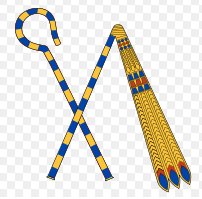
But at his
inauguration the flail
was changed into a Will:
'- that my father has given me before Geb. I have passed
through the land and touched the four sides of it. I traverse it as
I desire ...
The flail is an
instrument for threshing and the crook is for the shepherd. I have
seen it used (by way of TV) on Crete, where the shepherd caught a
sheep by the throat with the crooked end of his staff. It was easily
done and the poor animal was hauled in for the slaughter.
In the picture above
we can count to 12 +
12 = 24 units of measurement on the crook and 13 on the flail, and
together crook and flail basically describe the form of 'X':
...
Mummies of pharaohs have their arms crosswise over their chests
according to a TV program I happened to watch.
The Inca kingdom
was called Tawantinsuyu = 'the indivisible four quarters
of the world' and the Inca himself was ruling in its center
(Cuzco) ...
But a 14th unit 'expands' into the 3 beautiful
'arrows'
on the right side of the flail, ending below the rest of the
arrangement. The crooked end of the crook, on the other hand, is
higher up than the rest. Like a sickle the crook spells 'end', while
contrariwise the flail ought to spell 'birth'. The sheep are grazing
above ground, but the grains are growing down in the earth, and Geb
was the god of earth.
Counting units on
the right part of the flail is difficult because the picture is not
sharp enough, but beyond the 'elbow' (at the top) I guess we can find
3 * 36 = 108 units. We can see 19 yellow and 1 red wedge on each
'arrow' in the
lower part, i.e. 3 * 20 = 60 units. If I have guessed right then
there will be 108 - 60 = 48 more to identify. There are 2 + 2 + 1 =
5 blue units on each of the 3 arrows, and 3 * 5 = 15. There might be
3 * 9 yellow wedges higher up, i.e. 3 * 9 + 3 * 19 = 3 * 28 = 84
yellow units in all. The red ones are 3 * 3 = 9. Summing up: 15
(blue) + 84 (yellow) + 9 (red) = 108.
That the design of
the arrangement is 'cosmic' in character seems to be beyond doubt.
The distinction left-right (for crook respectively flail) was
probably of no great importance in Egyptian art, and instead the
major distinction apparently is front side (crook) contra back side (flail),
which can be seen for instance in the following picture (from
Wilkinson):
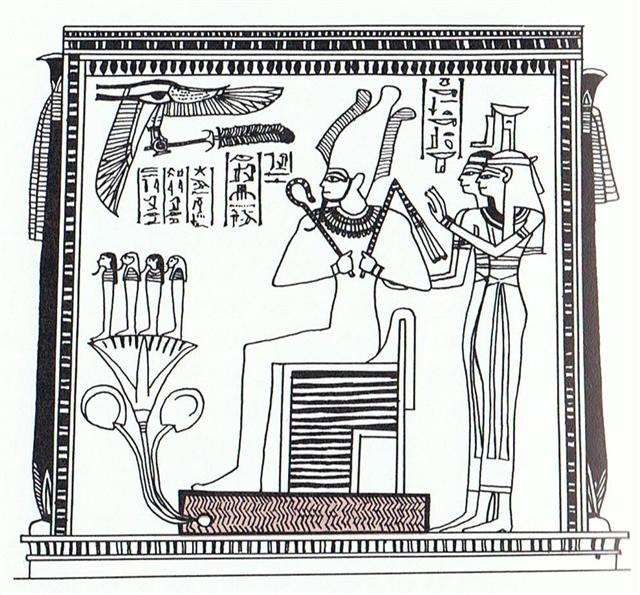
The 4 sons of Osiris
are here standing on top of a flower growing from a 'mata' in the
water basin at center bottom. The picture is from the 19th dynasty
(around 1200 BC).
In the Dendera zodiac
the bluemarked 'Orion' sign apparently is a pharaoh, because he carries a flail in his
right hand and a was staff in his left:

The crook is not
there, which is as it should be if Spring Sun has 'fallen' (cfr the
preceding Taurus).
According to
Wilkinson the earth god Geb (who was married to Nut,
the goddess of the Sky) was often depicted as a man with a goose on
his head. In Budge's Book of the Dead we can read:
"Seb or Qeb ... the fourth member of
the company of the gods of Annu, was the son of Shu, husband of Nut,
and by her father of Osiris, Isis, Set, and Nephthys. Originally he
was the god of the earth, and is called both the 'father of the
gods' ... and the 'erpā
... (i.e., the tribal, hereditary head) of the gods'.
He is depicted in human form,
sometimes with a crown upon his head and sceptre ... [was
hieroglyph] ... in his right hand; and sometimes he has upon his
head a goose, which bird was sacred to him.
In many places he is called
the 'great cackler' ... and he was supposed to have laid the egg
from which the world sprang.
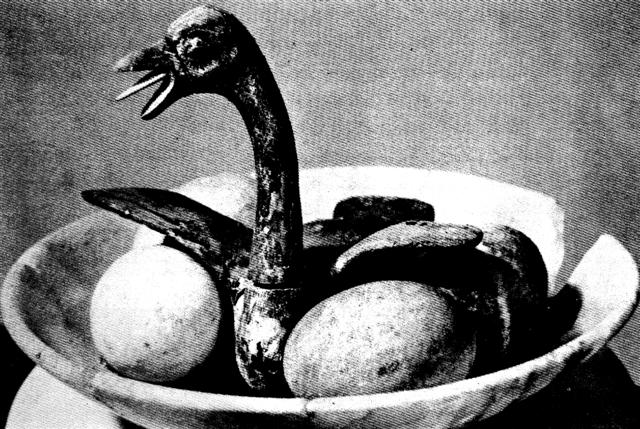
(picture from Wilkinson, at sesch - bird nest)
Already in the pyramid texts
he has become a god of the dead by virtue of representing the earth
wherein the deceased was laid."
Cfr also at vae
kore, where Kenkenur (the Great Cackler) is suggested (in
Hancock 3) to be an alias for the phoenix, and where the Easter
Island sooty tern is read as 'sunbird', manu-te-ra).
The bird behind
'Osiris' is not a goose, but maybe there is a goose diametrically
opposite, above Sagittarius.
But it could be a
lapwing (rechyt):
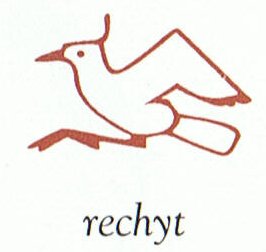 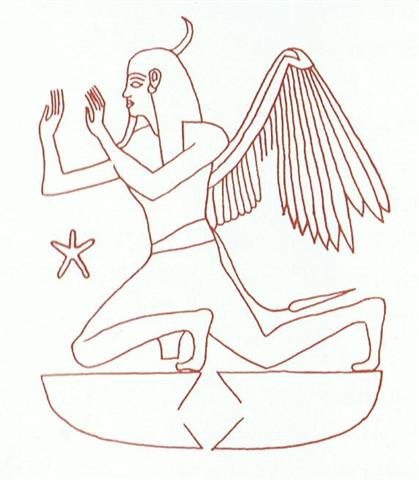
In the composition at
right we can see that the wing at the back is similar to the back
side of a flail. This view is strengthened by the fact that the last
3 'arrows' are grouped separately from the following 7. Then comes a
gap with 3 'threads', followed by 8 more but different kinds of
'feathers'. 3 + 7 = 10 could refer to the sun, while 8 could refer
to the moon. A gap separates them.
Wilkinson says that
early (ca 3000 BC) the lapwing seems to have symbolized the captured
peoples of Lower Egypt. The little forward oriented crest together
with the 'shadowing wing' may serve as marks of identification, I
suppose. The great star in front of the 'human lapwing' is
interesting.
At mauga the
following picture was presented, and in the crown of Lower Egypt at
left we can see that the 'scroll' resembles the crest of a lapwing -
though reversed (maybe the peoples of Lower Egypt now were on par
with those of Upper Egypt):
The sacred geography of ancient Egypt ought to have had the
bluemarked zodiacal signs (those below the ecliptic in summer)
corresponding to Lower Egypt.
|
|
Pharaoh in form of
Orion wears the headdress of Upper Egypt and the 'lapwing' evidently
represents Lower Egypt - from the highest to the lowest, a mirror
version of Te Pei to Te Pou:

She is one of the three central characters
in The White
Goddess:
"The Battle of the Trees was 'occasioned by a
Lapwing, a White Roebuck, and a Whelp from Annwm' ..."
Graves reports from
his own experiences:
"In Wales as a boy I learned to respect the lapwing
for the wonderful way in which she camouflages and conceals her eggs
in an open field from any casual passer-by. At first I was fooled
every time by her agonized peewit, peewit, screamed
from the contrary direction to the one in which her eggs lay, and
sometimes when she realized that I was a nest-robber, she would flap
about along the ground, pretending to have a broken wing and
inviting capture.
But as soon as I had found one nest I could find
many. The lapwing's poetic meaning is 'Disguise the Secret' and it
is her extraordinary discretion which gives her the claim to
sanctity. According to the Koran she was the repository of
King Solomon's secrets and the most intelligent of the flock of
prophetic birds that attended him."
So contrary to the
pomp and circumstance of the great king she who hides his eggs is
living close to the ground. Indeed, we can hardly see her in the
Dendera round zodiac:

In the outer circle
of figures we can detect what probably is a Sun Serpent upon a
'stone' below the blue
pair:
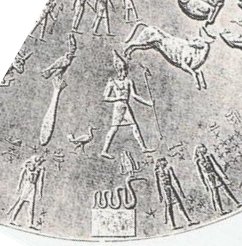
The snake has 3 undulations
and its head has a crown similar to that on the scarab we just
saw:
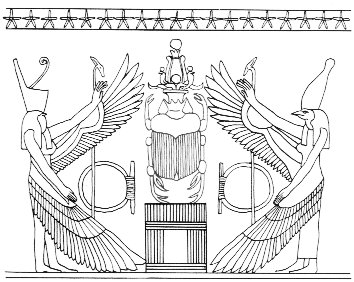
The rectangle
('stone') on
which the serpent is resting corresponds to the 'house' below the
scarab.
The secret which rechyt
here hides for us could be the location of the 'door' through which in the
Golden Age summer entered, i.e. when the twins (Gemini) were at
spring equinox:
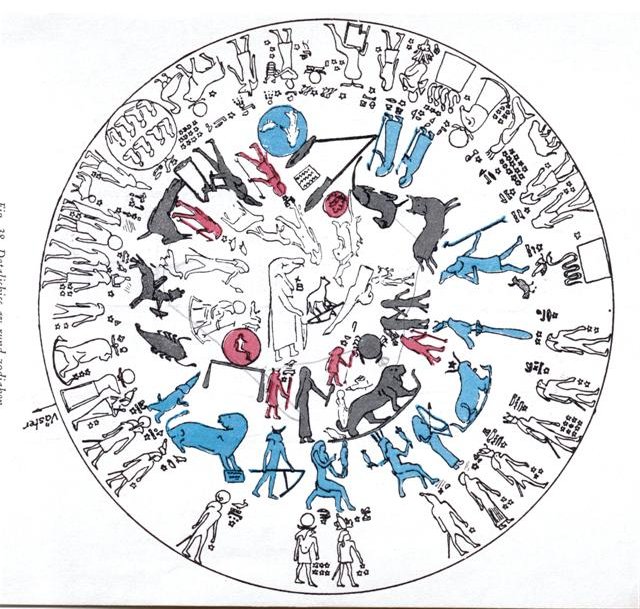
Above east is to the
right. The blackmarked Virgo is at summer solstice and Pisces at
winter solstice. Gemini can be understood as the pair of winter and summer. The
two fishes in Pisces could similarly indicate a crack in time
between the old and the new years (the upper one with a Sun eye and
the lower one maybe like a baby hippopotamus).
The great hole in
e.g. *Qa2-40 could possibly indicate the 'door' from winter to
summer:
 |
 |
 |
 |
 |
 |
|
*Qa2-40 |
*Qa2-41 |
*Qa2-42 |
*Qa2-43 |
Qa3-1 |
Qa3-2 (68) |
Instead of *Qa1-80
(for summer solstice) - which would have been impossible because the
glyph lines are not long enough - the creator of the Q text could
have decided to choose day 240 counted from winter solstice as a
sign,
thereby also indicating that 2 months have been added. In other words,
the text maybe describes the location of the great hole as
it was 2 zodiacal signs earlier than Pisces, in the Golden Age.
The Sun season
will after an interlude (cfr the 3 threads between the 10 outer
feathers and the 8 inner ones in the human rechyt figure) be followed by a Moon season. The empty
single ('cyclopean') eyehole is drawn above twin eggs. Sun is high in the
sky, but Moon is close to earth.
On Easter Island the
season of the great hole in the sky would in the Golden Age not have been
spring but autumn equinox. And because of
precession this location must nowadays have moved to winter solstice
- given
that the time of observation was the same and not had been changed from
morning to evening for instance. Or maybe the time of observation
was coordinated with the age of Sun - in early morning when Sun was
young, at noon when Sun was in his middle age, and in the evening
when Sun was old. The principle of correspondences ought to have had
such a consequence, I think.
In Qa3-1 a waning
moon crescent evolves into a nuku sign turned upside down,
which ought to mean that winter is over. In Qa3-2 the 'pitcher of
darknes' has a 5-maro feather garland hanging down, which I
read as 'the front side of the year is in front' and winter is in
the past. Glyph number 68 draws the line.
Remarkably, it was
also in the 3rd of his 12 adventures that Odysseus had his
ordeal with Polyphemus - not when he
had advanced halfway through his cycle. There is a 'door' in toru.
Also Heracles (Hercules) met Polyphemus, and - remarkably - it happened at a
water hole with an abandoned water pitcher (cfr at hanau).
|
|
When Polyphemus had
lost his single eye, bored through by the glowing hot olive stake
twirled around by Odysseus and those 6 of his chosen men who still
were alive (6 had been eaten), he intended to catch his tormentors:
"There remained, however, the
problem of getting out of the blocked cave. The Cyclops, groaning,
groping with his hands, lifted away the stone from the door, and
himself then sat at the entry.
And Odysseus cleverly lashed together three large
rams of the flock, 'well nurtured and thick of fleece, great and
goodly, with wool as dark as violet'. And he prepared in all six
triads of this kind. The middle ram of each set was to carry a man
clinging beneath, while the side pair were to give protection. And
as for himself, he laid hold of a goodly young ram, far the best of
all, and curled beneath his shaggy belly; and as soon as early dawn
shone forth, the nineteen rams, together with the flock, issued from
the cave, bearing seven men ..." (Campbell 3)
The Ram arrives
after Pisces, but at the time of Homeros the Ram was at spring
equinox (i.e. the 3rd sign from winter solstice), and the escape was
significantly timed to early dawn:

The numbers,
though, suggest a location halfway through the cycle: 6 out of 12
men (or 13 including Odysseus) had disappeared down into the mouth of
Polyphemus. The number of rams instrumental for helping the company to emerge from the cave were 3 *
6 = 18, and 'one more'. Underneath these rams his men were clinging, in
the center of each triad, while Odysseus himself was beneath the
belly of the best of the beasts. 7 men out of 13 survived.
Maybe the Q text
describes events in the age of the Ram. At any rate we must notice
how there is a sign of lashing together into a unit what presumably
represents time periods, which we ought to recognize from earlier
(cfr at toki):
... He took resinous
wood, split it and stuck the splinters in his hair. Then he lashed
two boats together, covered them with planks, danced and sang on
them, and so he came to the old man's house. He sang: 'O, I go and
will fetch the fire.' The old man's daughter heard him singing, and
said to her father: 'O, let the stranger come into the house; he
sings and dances so beautifully.'
The stag landed and drew
near the door, singing and dancing, and at the same time sprang to
the door and made as if he wanted to enter the house. Then the door
snapped to, without however touching him. But while it was again
opening, he sprang quickly into the house. Here he seated himself at
the fire, as if he wanted to dry himself, and continued singing. At
the same time he let his head bend forward over the fire, so that he
became quite sooty, and at last the splinters in his hair took fire.
Then he sprang out, ran off and brought the fire to the people ...
|
|
The lapwing is not
the only species of plover. The following bird is a 'golden plover'
of a kind which appears in the Pacific:
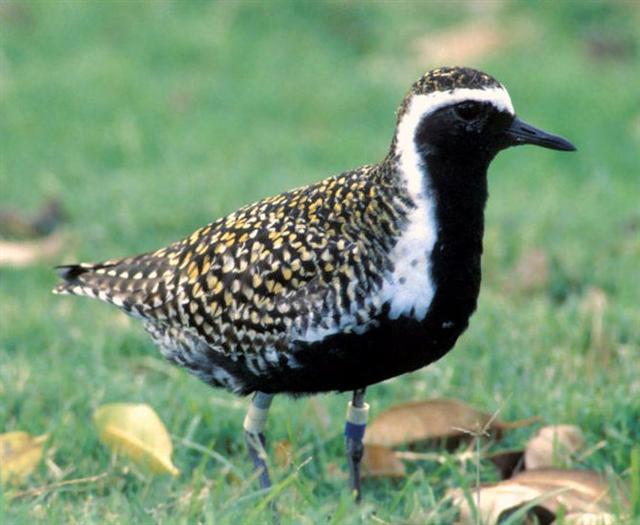
(Pacific Golden Plover, Pluvialis fulva,
according to Wikipedia)
At vae a myth
was quoted, in which a Golden Plover has a central role:
...
There is a
couple residing in one place named Kui and Fakataka.
After the couple stay together for a while Fakataka is
pregnant. So they go away because they wish to go to another place -
they go. The canoe goes and goes, the wind roars, the sea churns,
the canoe sinks. Kui expires while Fakataka swims.
Fakataka
swims and swims, reaching another land. She goes there and stays on
the upraised reef in the freshwater pools on the reef, and there
delivers her child, a boy child. She gives him the name
Taetagaloa. When the baby is born a golden plover flies over and
alights upon the reef. (Kua
fanau lā te pepe kae lele mai te tuli oi tū mai i te papa).
And so the woman
thus names various parts of the child beginning with the name 'the
plover' (tuli): neck (tuliulu), elbow (tulilima),
knee (tulivae) ...
The phenomenon of
changing seasons is here described by the man drowning while the
woman is managing to reach a new land and there give birth to the next
generation. This birth happens at the border line between sea and land, on the
reef. There is an equivalence between sea and land on one hand and
winter and summer on the other. Spring equinox will thus be equal to
the reef.
At the border a birth
occurs. And this border line is where a plover should be located. In
Lower Egypt the interface lies in the marshes between sea and land,
while on an island
the interface is its reef.
3 kinds of 'joints' (turi,
tuli) are mentioned - neck, elbow and knee, in falling time
order, and we can guess these as referring to the 3 periods of Spring Sun.
A plover means a
'rain bird':
Plover ... name of several
grallatorial [wading] birds, (pop.) lapwing ... f. L. pluvia
rain ..." (English Etymology)
With Spring Sun gone
the season turns into a gray and rainy one. But at other major changeover
'stations' the plover can also be used, viz. as a symbol for the basic idea,
which is seasonal change, a 'daybrake'. The flapping wing of a
lapwing illustrates a broken wing. This is underlined by the golden plover hovering above the
newborn baby boy Taetagaloa, because Fakataka puts
names on the changeover stations (tuli) between his 'limbs'.
We should remember
the words of Ogotemmŕli (cfr at hakaturou):
... During his descent
the ancestor still possessed the quality of a water spirit, and his
body, though preserving its human appearance, owing to it being that
of a regenerated man, was equipped with four flexible limbs like
serpents after the pattern of the arms of the Great Nummo.
The ground was rapidly
approaching. The ancestor was still standing, his arms in front of
him and the hammer and anvil hanging across his limbs. The shock of
his final impact on the earth when he came to the end of the
rainbow, scattered in a cloud of dust the animals, vegetables and
men disposed on the steps.
When calm was restored,
the smith was still on the roof, standing erect facing towards the
north, his tools still in the same position. But in the shock of
landing the hammer and the anvil had broken his arms and legs at the
level of elbows and knees, which he did not have before. He thus
acquired the joints proper to the new human form, which was to
spread over the earth and to devote itself to toil ...
Grallatorial means walking on stilts.
|
|
In China, we have
seen, there is a great hole formed by 13 (?) stars located between
'Bow and Arrow' and Orion:
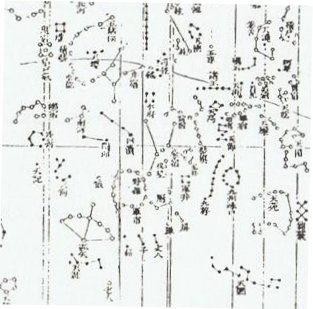
A smaller hole with 9
stars are to the right of Orion. We can also see that the arrow
seems to be aiming at the top of a straight vertical 'pole' with 8 stars, reminding us
of how Satit according to the round Dendera zodiac apparently
is
aiming at the perching bird on the 'pillar' beyond the Sothis
cow.
In Allen we can find
the constellation Lepus (the Hare) below and slightly to the left of Orion. The stars
in this region do not suggest any obvious circular form as far as I
can see (the pictures below are from Wikipedia):
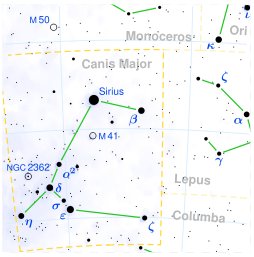
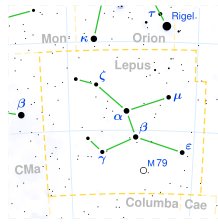 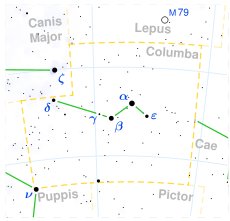
Maybe the Chinese
'great hole' constellation is a combination of stars in Canis Major
(including Sirius) and Lepus.
Allen associates
Lepus (an ancient constellation) with the moon and he takes the
opportunity to diverge into how the patterns on the moon were
perceived
in different times and places. Considering how Lepus comes below
Orion I think the association to the Moon is quite in place - next phase
beyond the blind Orion ought to be a season of Moon, especially if
it is located further down.
For our present
purposes a few comments from Allen are noteworthy:
"Hewitt says that in earliest Egyptian
astronomy Lepus was the Boat of Osiris, the great god of that
country, identified with Orion. The Chinese knew it as Tsih,
a Shed."
"Brown writes of the often discussed comparative
location of Lepus and Orion:
The problem which perplexed the ancients, why the
Mighty-hunter and his Dog should pursue the most timid of creature,
is solved when we recognize that Orion was originally a solar type,
and that the Hare is almost universally a lunar type;
and mentions the very singular connection between
this creature and the moon shown on Euphratean cylinders, Syrian
agate seals, Chinese coins, the Moon-cakes of Central Asia, and in
the legends of widely separated nations and savage tribes."
"Other near-by-stars [than
α], presumably in Lepus, were
the Chinese Kuen Tsing,
an Army Well, and Ping Sing,
the Star Screen."
We can guess it was
this Army Well which inspired the picture of a 'great hole' in the
Chinese star map above.
A Star Screen is for hiding, of special
interest for such 'lapwing' types as hares. The idea of a screen is
not far from the idea of a 'black cloth'.
A bird with a broken
wing (like the illusory one of the lapwing, rechyt) is found
among the stars, number 529 in Makemson:
"529. Rehua; an
important Maori star and an influential god, elder brother of
Tane dwelling in the tenth heaven. Rehua has been
variously identified with Jupiter by Tregear, with Sirius by
Stowell, and with Antares by Best, and there can be no doubt that
the name was applied to different objects in various sections of New
Zealand.
And old native
declared: 'Rehua is a star, a bird with two wings; one wing
is broken. Under the unbroken wing is Te Waa-o-Tamarereti
(the Canoe of Tamarereti is the Tail of Scorpius in this
instance). When Rehua mates with his wife Pekehawani
(a star close to Antares) the ocean is windless and motionless.'
Antares, visible in the
morning sky of December-January, came to stand for summer heat;
hence the saying, 'Rehua cooks (ripens) all fruit'.
The generally accepted
version of the Rehua myth, according to Best, is that
Rehua had two wives, the stars on either side of Antares. One
was Ruhi-te-rangi or Pekehawani, the personification
of summer lanaguor (ruhi), the other Whaka-onge-kai,
She-who-makes-food-scarce before the new crops can be harvested ..."
Was
it pure coincidence that Rehua became number 529? This number
can be 'translated' as 5 (fire) and 29 (darkness). By the star's
position in between his 2 wives it resembles Alnilam (in the
center of the Belt of Orion). Another myth is using this pattern
too, and - significantly - the story includes a stone which
covered a hole.
|
|
"Listen, you of enlightended minds, //
While I tell you a tale of the shore. // Two sisters who
lived together Hava and Ila, // They were
wives of Naa ana moana. // They lived together
then they quarrelled. // What a sad thing is jealousy -
Ala!
Here in Tongatapu long ago a chief
named Naa ana moana had two wives who were
sisters, Hava and Ila. They-two came from
across the sea at Nukunukumotu, and Ila
was the favourite wife.
These wives went fishing for Naa's
food, they always tried to please him with their catch.
When there was a raui on fishing in the lagoon,
they went out on the reef for crabs. But the time came
for the raui to be lifted, therefore they tied up
leaves for torches and went nightfishing in the lagoon
once more. But they went off separately, those two.
Hava went along the shore past the
mangroves and Ila went on the shallow part of the
lagoon. With their spears and torches they looked for
good food.
Beyond the mangroves, Hava came to
a cave in the land, and in that cave she found a hole
that was covered with a stone.
Came and opened it, // She thought it was
a crab-hole. // Looking in she saw the fish with pouting
mouths. // Brought her basket, // Opened it out, //
Chose the biggest fish, // Lifted up her load, //
Wishing to have something to take to her husband.
Indeed Hava lifted the stone from
that hole and found that it was filled with mullet: all
the mullet of the world were in that hole. Therefore she
fetched her basket and picked out the biggest fish and
took them to Naa. When she had gone the hole was
teeming with mullet again.
Now Ila her sister brought home
only crabs that night, and when she saw the many mullet
which Naa was scaling and cutting she was
jealous, for Naa was pleased with Hava.
Those wives again went fishing on another
night, and Ila thought there was something
Hava knew. They-two went down to the mangroves and
they fished there for a while. Then Ila set off
for her lagoon-place again, and seeing her go, Hava
left her torch burning on a mangrove tree and went on to
her cave.
Ila also deceived her sister. She
too left her torch burning in a mangrove tree, and in
the dark she followed Hava.
And Hava, thinking that she was
alone, went in and lifted up the stone and filled her
basket to the brim with fish. Then she returned to her
husband.
Ila went in also and lifted the
stone, she filled her basket with fish to take to Naa.
But she was angry with Hava, angry because of her
secret. Therefore she threw away the stone and called to
the fish: 'You come out and you go!'
And all those mullet came, they streamed
in thousands from the hole and leapt into the sea. They
were the first mullet in the world.
When Hava reached their house at
midnight she was cold. She therefore put on clothes
while Naa cleaned the fish. But while he was
doing that Hava heard a great rushing sound like
thunder and she cried. 'The fish! The mullet! They have
all been let out by Ila!'
Straight off she rushed, she dashed out
in the night to prevent her mullet from escaping.
She looked for rocks to block their way,
that woman. And with her hands indeed she pulled in the
islands Kanatea and Nuku to close the
cave. When they would not do so she pulled Houmaniu
close. The teeming fishes turned in their flight and
like a wind they rushed to the other shore, which caused
the small bay which is there today.
Then Hava seeing them escaping
pulled with all her strength at Toa as well, but
the fishes sped back to Folaha, and dented that
shore also with their rushing force.
Still Hava persevered, she pulled
the ends of the land, Haaloausi and
Haoumatoloa. She also tugged at Mataaho, the
island where the giant ironwood tree is growing; but
that tree would not move:
Was nearly dragged along the toa
tree; // But the fish turned, // Which made the inlet at
Lifuka, // And the inlet at Faihavata, //
And the beach at Fatufala - Ala!
Pulled out Haaloausi, // Turned
the fish to the other side, // Which caused the inlet at
Umusi // Near to the rock called Tuungasili,
// Afterwards known as Tui - Ala!
When daylight came and the flowing of the
fish had not been stopped Hava grew intensely
angry, she cried out to her own land across the sea, to
Nukunukumotu, for all her people to come and
catch the fish.
All the Nukunukumotu stood and
waited for the fish, but they escaped at Fota,
Nukunukumotu could not stop them, those mullet
utterly escaped.
Then indeed Hava turned herself
into a coral rock. And the mullet escaped and increased,
and mullet thenceforward were everywhere.
After this Hava was a coral rock
for ever, but her husband joined her. From his love for
her, Naa also became a stone. And Ila said
what is the use of living and became a stone as well.
They are standing together in the
lagoon-entrance of Tanumapopo, Hava on the
one side and Ila on the other, and Naa ana
moana in between them. This is true."
(Legends of the South Seas)
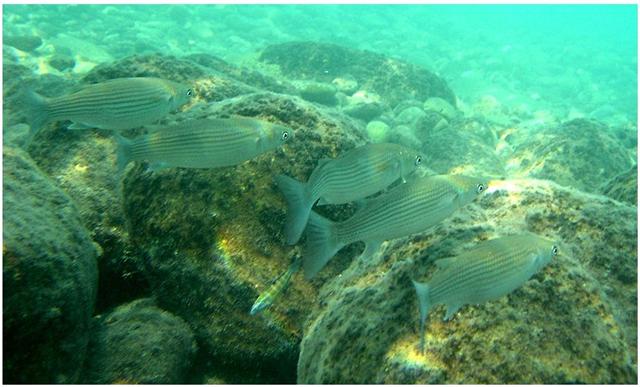
(Wikipedia) |
|